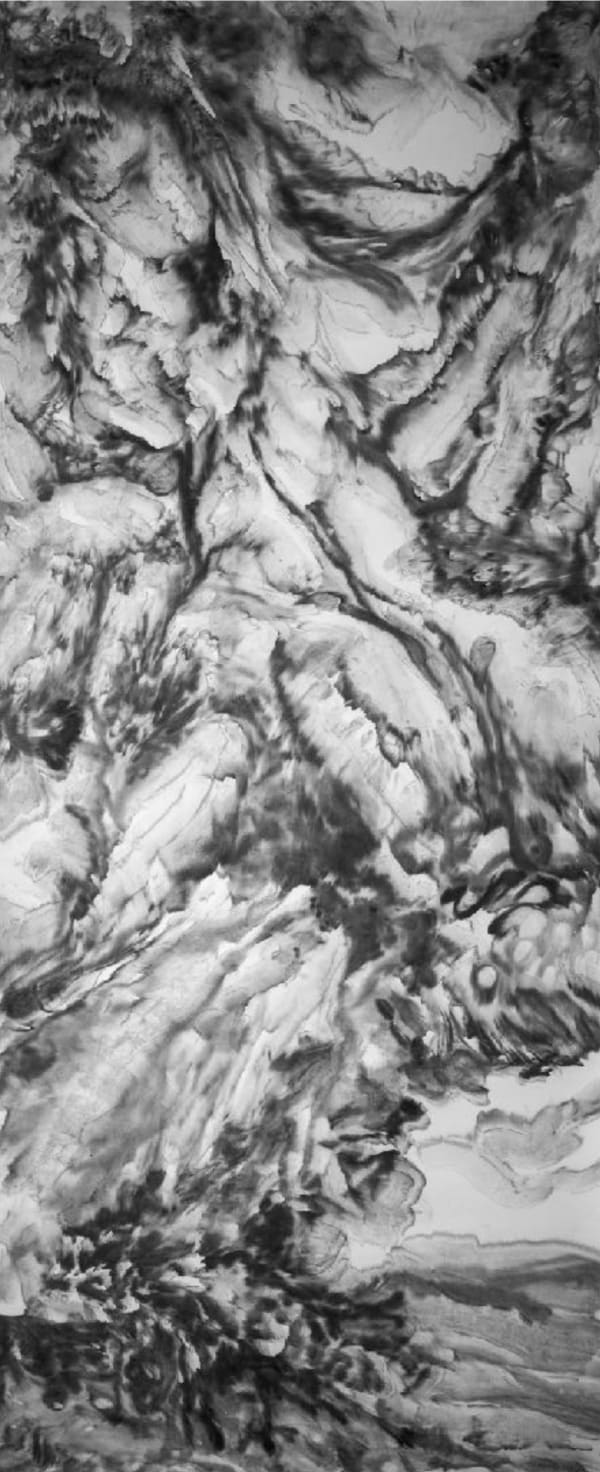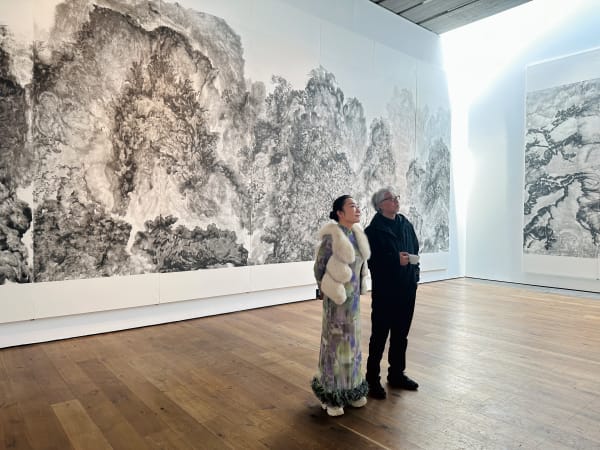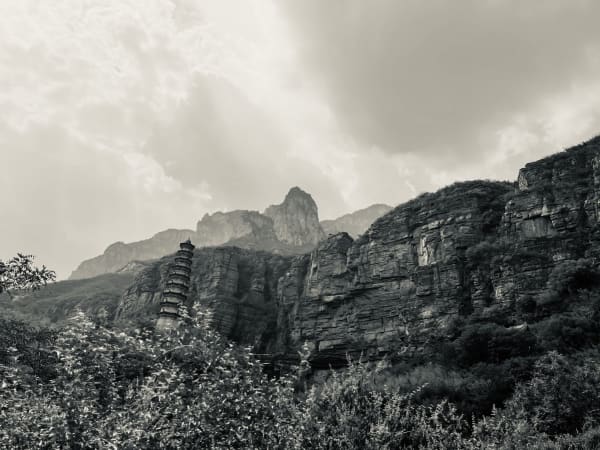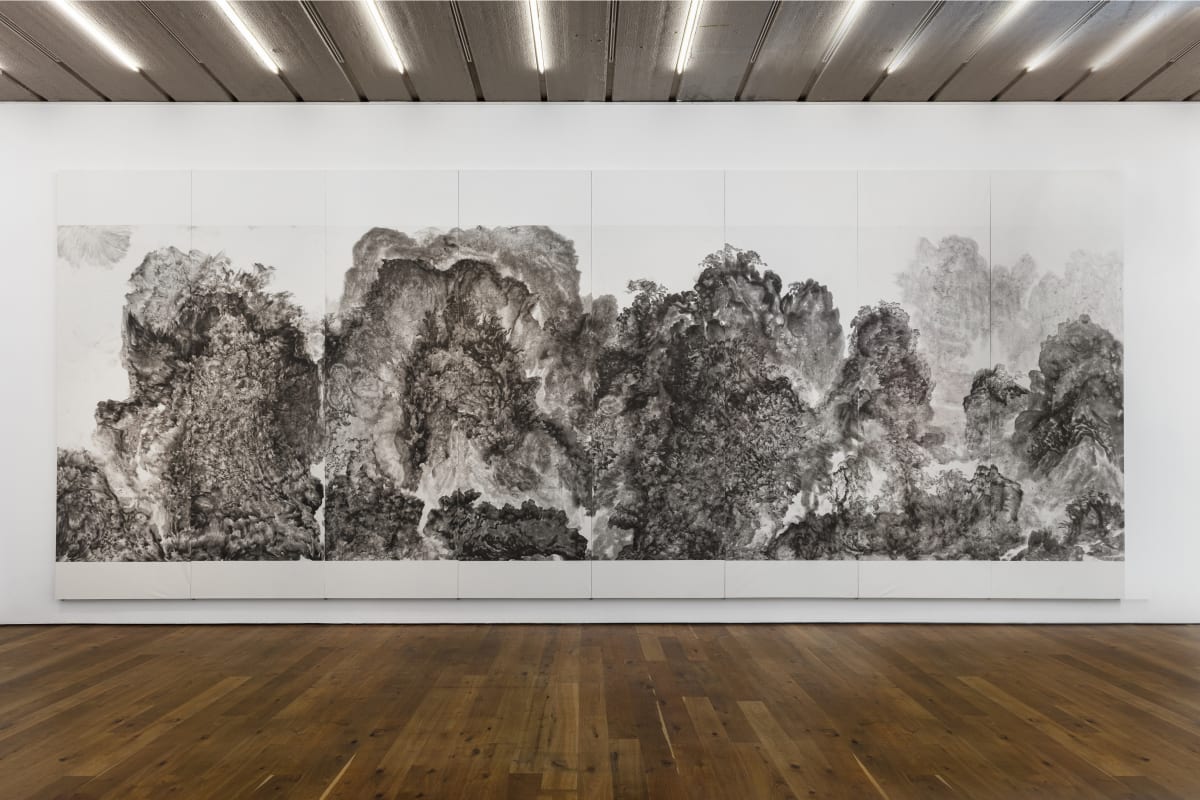Bingyi: The Eyes of Chaos
INKstudio is proud to announce the opening of Bingyi’s third solo exhibition at the gallery entitled “Bingyi: The Eyes of Chaos.” An artist, architectural designer, curator, cultural critic, and social activist, Bingyi has developed a multi-faceted practice that encompasses land-and-environmental art, site-specific architectural installation, musical and literary composition, ink painting, performance art, and filmmaking. In “The Eyes of Chaos” INKstudio will debut Bingyi’s latest grand, speculative narrative about Art and its relationship to Nature, Literature, History and Politics as retold or reimagined from a woman’s point of view.
Bingyi tells her story through two bodies of work resulting from her investigations over the past five years into the origins of the ink monochrome landscape in China: The Eyes of Chaos: Temple of the Matriarch of Painting—the organic development of Bingyi’s land-and-environment art practice into historical landscape painting; and Dream within a Dream within a Dream—a speculative, archaeological reconstruction of the life of Hua, the “Matriarch of Painting.” Hua, it turns out, was not only a visionary woman artist but a philosopher and political thinker who, in the Northern Song, created an alternative aesthetic system that de-centered the Patriarchal, Confucian, Brush-centered and Humanistic mode of literati landscape painting and, from a Woman’s point of view, re-centered the expressive possibilities of brush and ink on Ink and Water, on Taoism and on Nature.
The Eyes of Chaos: Temple of the Matriarch of Painting
In the first-floor galleries, Bingyi will debut her monumental ink-monochrome landscape painting installation entitled The Eyes of Chaos: Temple of the Matriarch of Painting created during her 2020-2023 research trips to the Taihang Mountains in Northern China’s Eastern Yellow-River Loess. As the home to Jing Hao (c. 855 – 915) of the Five Dynasties Period (907 – 960)—famed author of the Bifaji or “Notes on Brushwork” and founding theorist of the Chinese ink-monochrome landscape painting tradition—and three ink painters of the Song Dynasty (960 – 1279)—Fan Kuan (c. 960 – c. 1030), Guo Xi (c. 1020 – c. 1090), and Li Tang (c. 1050 – 1130)— who defined monumental landscape painting practice, the Taihang Mountains are both the historical and spiritual birthplace of the Chinese landscape painting tradition.
The installation is modeled on Northern Song temple architecture and Bingyi imagines her Taihang series landscapes as the architectural paintings in the Temple for Hua the “Matriarch of Painting” recently rediscovered by Bingyi the archaeologist deep in the Taihang Mountains:
The first sight of the Temple of the Matriarch of Painting shows that an unknown civilization has long existed. The Eyes of Chaos comes from a grand and magical narrative, starting with the archaeological discovery of The Temple of the Matriarch of Painting. In the depths of the Taihang Mountain, the archaeologist Bingyi excavated the entrance to the Temple and thus discovered another magical and unknown civilization parallel to the Northern Song Dynasty.
At this point in her speculative narrative, Bingyi, the archaeologist, uncovers a new form of ink monochrome landscape from deep within the historical and spiritual birthplace of the Chinese landscape tradition and, with it, uncovers the existence of a woman, perhaps the temple’s patron, provocatively named Hua 嫿,the “Matriarch of Painting.”
The central masterwork of Bingyi’s Taihang series is the eponymous Taihang Rhapsody, 2022-2023, a truly monumental and immersive eight-panel work 3.7 meters high and 12 meters wide. Flanked by single panel landscape compositions inspired by the real Taihang landscape—as in Secluded Forest in Flying Waterfalls 幽林飞瀑图—by historic masterworks such Dong Yuan’s “Riverbank”—as in Chaos Opens 混沌初开—and by ancient masterworks lost to history but recorded in art historic texts—as in Cold Mountains in Dancing Snow 寒山飞雪图—the entire installation is a temple both to Nature and to the history of Chinese landscape painting with the Taihang Mountains serving as the central subject and context in both cases.
Dream within a Dream within a Dream
Bingyi’s narrative continues with her second body of work, Dream within a Dream within a Dream—a trove of paintings and texts by Hua herself recovered by Bingyi, the archaeologist, at the site of the Temple of the Matriarch of Painting. According to the excavated texts, Hua was born in 1156, the year after the death of Li Qingzhao (1084 – 1155), China’s greatest female poet. Was Hua the reincarnation of Li Qingzhao as China’s greatest woman painter, lost to history until this extraordinary discovery?
Furthermore, among the discovered texts were writings such as the “Sutra of Madness” that had only recently been recovered through research on the long-lost Lotus Dynasty. Philological research then confirmed a stunning discovery: Hua was not only the Matriarch of Painting but also the spiritual founder of the Lotus Dynasty!
In 2018, Bingyi debuted a new artistic practice employing “speculative archaeology” whereby a historical discourse is interrogated through the creation and archaeological contextualization of counterfactual artifacts. Specifically, she created a series of handscrolls and classic texts which the archaeologist Bingyi discovered during the demolition of an old library that document the existence of the Lianchao or “Lotus Dynasty”—“a utopian society that exists in a slip of time after the Southern Song where wars are fought not with weapons but with poetry, where rivers flow with fragrance instead of water, and where the capital city contains not palace buildings but only mountains and streams filled with music.’”
Through her Matriarch of Painting, Bingyi speculates on a world and an aesthetic system built upon a woman’s point of view. In the name of "嫿", Bingyi has created a complete set of political, economic, painting and religious classics, as well as related aesthetic systems encompassing painting, architecture, poetry, calendrical studies and history. Whether murals, screens, hand scrolls or fans, landscape painting, figure painting, paintings on poetic themes or classical allegories, Bingyi explores the possibilities of classic painting forms and subjects when re-centered on a woman’s perspective.
In the Dream Within a Dream Within a Dream scrolls, the Matriarch of Painting creates an exquisite literary, conceptual and architectural complex that reimagines the space-time relationship between various literary traditions over the past two thousand years. Each of the scrolls is a magical allegory drawn from an ancient text. Each scroll starts with a historical remnant or reminiscence, then unfolds into the main narrative scene, and finally completes itself with a final image or poem written in one of the Matriarch’s distinctive antique calligraphic styles. In the piece entitled the Dream of South Branch 南柯一梦, for example, the Matriarch begins her journey with a baimiao painting of a feather which symbolizes the fragrance of the dream, then continues into the main scene where the character Chunyu Fen 淳于棼 “Chenyu the Confused” sleeps underneath a giant pagoda tree with the king and his alter ego embracing each other as a cloud sitting on a rock while the two diplomats who received Chunyu into the unknown country named Pagoda hide in a cave. The third part of the handscroll is a text that the Matriarch wrote in ancient guwen style which raises the ultimate question: Do we really understand who we are, what we see, or where we come from?
Bingyi: The Eyes of Chaos is the worldwide debut of Bingyi’s speculative grand narrative about the life of Hua, Bingyi’s Matriarch of Painting. The Eyes of Chaos: Temple of the Matriarch of Painting is the premier of Bingyi’s Taihang series landscapes in China and the first time Bingyi’s complete vision for the Taihang temple installation will be fully realized. A smaller version of this installation was debuted at the Philadelphia Museum of Art in 2022 by curator of Chinese art and head of the East Asian Art department, Hiromi Kinoshita, an earlier four-panel composition of the Taihang Mountains was exhibited at the Asia Society in Houston in 2023 by independent curator and scholar, Susan Beningson, and a full version of the installation has been selected for a forthcoming solo exhibition for the artist at a major North American museum.
-
 Bingyi 冰逸, Taihang Rhapsody 太行赋, 2020-2023
Bingyi 冰逸, Taihang Rhapsody 太行赋, 2020-2023 -
 Bingyi 冰逸, Eyes of Chaos: Dharma 混沌之眼:达摩
Bingyi 冰逸, Eyes of Chaos: Dharma 混沌之眼:达摩 -
 Bingyi 冰逸, Cold Mountains in Dancing Snow 寒山飞雪图, 2021-2023
Bingyi 冰逸, Cold Mountains in Dancing Snow 寒山飞雪图, 2021-2023 -
 Bingyi 冰逸, Secluded Forest in Flying Waterfalls 幽林飞瀑图, 2021-2023
Bingyi 冰逸, Secluded Forest in Flying Waterfalls 幽林飞瀑图, 2021-2023 -
 Bingyi 冰逸, Chaos Opens 混沌初开, 2022
Bingyi 冰逸, Chaos Opens 混沌初开, 2022 -
 Bingyi 冰逸, Dream of South Branch 南柯一梦, 2019-2023
Bingyi 冰逸, Dream of South Branch 南柯一梦, 2019-2023 -
 Bingyi 冰逸, On Top of Mount Jieshi 东临碣石, 2019-2023
Bingyi 冰逸, On Top of Mount Jieshi 东临碣石, 2019-2023 -
 Bingyi 冰逸, Dragon Pines in Lonely Valley 龙松幽谷图, 2022
Bingyi 冰逸, Dragon Pines in Lonely Valley 龙松幽谷图, 2022 -
 Bingyi 冰逸, Mountain and Water as Clouds 山水如云, 2023
Bingyi 冰逸, Mountain and Water as Clouds 山水如云, 2023 -
 Bingyi 冰逸, Map of the Sacred Mountain《圣山图》——考古地图, 2019-2023
Bingyi 冰逸, Map of the Sacred Mountain《圣山图》——考古地图, 2019-2023 -
 Bingyi 冰逸, Wave Painting: Bamboo 波相绘画:竹, 2019-2023
Bingyi 冰逸, Wave Painting: Bamboo 波相绘画:竹, 2019-2023 -
 Bingyi 冰逸, Mountain and Flowing Water 高山流水, 2019-2023
Bingyi 冰逸, Mountain and Flowing Water 高山流水, 2019-2023


















